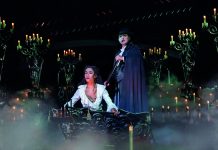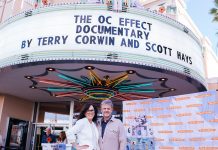
Ever since the first caveman (let’s assume it was a man) put charcoal to cave wall, people looking at the finished work judged it as either compelling or not. Nevermind the process or idea behind it – that was the artists’ business. Then, during the 1960s and early ’70s, men and a smattering of women suddenly declared that art as the world knew it – or at least the preeminence of the created object – was dead. All that mattered was the idea behind it. Calling their output “Conceptual Art,” this new breed, incomprehensible to many, elevated into art the process of digging trenches into a beach, contorting their faces into clownish expressions before letting themselves be photographed, or building approximations of rooms impossible to enter to all but chimpanzees, or climbing into boxes waiting to be shot.
This relatively short-lived segment of art history is re-evaluated in “State of Mind: New California Art 1970,” the current show at the Orange County Museum of Art that is bound to attract audiences including young artists whose (grand)parents might have grooved to impromptu performances known as happenings, the more outlandish the better. Performance art, part of the exhibition, came into being then, a mix of European street performance (think buskers and mimes) and American West Coast originality, fueled by rapid social changes accelerated by anti-Vietnam war protests and the nascent women’s and environmental movements.

Here one can ponder Robert Kinmont (“8 Natural Handstands”), who had himself photographed doing handstands en plein-air to suggest solidarity between man and his environment, Ed Ruscha (“Every Building on the Sunset Strip”) who found poetry in the stylistic jumble of LA strip mall architecture, Paul McCarthy (“May 1, 1971”) who saw art in the random comings and goings of a San Francisco intersection, and John Baldessari (“California Map Piece”) who drove the length of the state to carve letters forming the word California into the actual environment to replicate what was pictured on a map.
Artists were abandoning their studios, if they even ever had them, testing the limits of public understanding, while declaring traditional art fit for the rubbish bin of art history. John Baldessari famously declared: “I Will Not Make Any More Boring Art.”
The husband-and-wife team of Helen Mayer Harrison and Newton Harrison are represented by their “Book of Lagoons,” an oversized folder with mylar-bound pages that the public is welcome to browse and find maps and aerial photographs accompanied by descriptive and free-form text composed by the artists. Then again, a radicalized architectural collective operating under the moniker “Ant Farm” had their adherents believe that some day we’d live and work in portable pods. (“Ant Farm: Truck Stop Network: Phase One”).
Co-curators Constance M. Lewallen and Karen Moss have put together a mix of well and lesser known artists and their work that may vex but nonetheless stands out due to consistent technical quality.
Conceptualism has its aficionados and others who passionately hate it, but the historical underpinnings of the show will unite both factions, especially since photography plays such a lead role. In retrospect, some seems loony while others make sense, and whether it’s art is ultimately up to viewers.
Assuming that the curators also had a hand in exhibition design, they should be credited with staging a show that is easily readable and will thus hold audience interest. And, hey kids, even the “eeew” factor has its place, in Suzanne Lacy’s 1976 series “Anatomy Lessons,” featuring a replica of an eviscerated sheep and of a woman with her bulging entrails in full view. It should be noted that “Frankenstein,” Lacy’s 1974 video still shows a woman drawing blood and not, as some suggested, shooting up drugs.
The curators have included seminal women artists, most of whom were carving their niches outside of the art establishment. Eleanor Antin’s back views of her nude self in the series “Carving” is even more apropos today than she, trying to lose weight at the time, could have imagined.
Bonnie Sherk’s “Sitting Still” series includes a gem that pictures her in one cage adjacent to another housing a tiger. The image of Sherk calmly eating lunch while the beast seems to be contemplating her as a possible dietary supplement makes one recall how women managed to prevail in a then-male-dominated, often outright hostile art scene.
Lewallen and Moss designed a clearly laid out, readable show that should appeal to diverse audiences. They can also boast a few works that have not been shown in museums before, such as Steve Kallenbach’s “Raised Floor” and Bruce Nauman’s mind-blowing “Yellow Room.”
“This is the art that lies at the root of much that is being done today,” said Lewallen.
While “State of Mind” has top billing, a second exhibition at the museum, “Two Schools of Cool” curated by Sarah Bancroft, shows how creativity handily overcomes perceived generation gaps through communication and collaboration between “old masters” and young artists.
For example, she has paired Ed Moses with Robert Williams, known for his Zap comics and penchant for cartoon art. While Moses creates abstract shapes formed from vintage fabrics, Williams weighs in with “Swap Meet Sally” and “Gimme, Gimme, Gimme,” which should be turned into a Wall Street mural. Llyn Foulkes and Stanya Kahn, on the other hand, evoke no more than “yeeech, enough already.”
Better to look at Baldessari and Shana Lutker whose collaboration examines the importance and perception of objects. Fortunately, we will soon be able to examine Bancroft’s overall curatorial talent via the long-awaited Richard Diebenkorn retrospective, due to appear next year.
“State of Mind: New California Art, Circa 1970” and “Two Schools of Cool” will be on exhibit at the Orange County Museum of Art through Jan. 22. For details, visit ocma.net.




